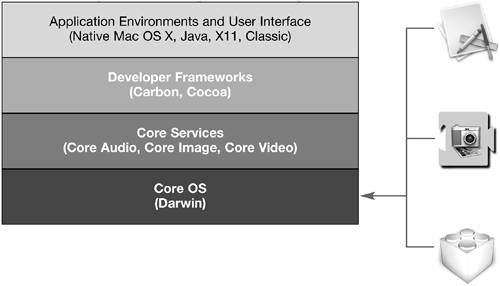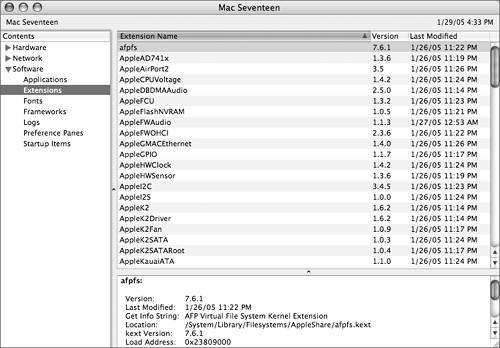Understanding Device
Drivers
Drivers are programs that enable a computer to
access and interact with hardware devices. Traditionally, drivers
are thought of as existing at the lowest levels of the operating
system. However, Mac OS X has three distinct types of drivers:
kernel extensions, plug-ins or modules, and applications.

Kernel extensions (KEXTs) are pieces of
software, provided in .kext files, that add functionality to the
operating system kernel (Darwin). They are not the same thing as
extensions in Mac OS 9. By default, kernel extensions are stored in
/System/Library/Extensions. One type of kernel extension is a
device driver. Mac OS X uses device drivers to provide system-wide
or low-level functionality for a connected device, such as being
able to read and write storage devices or read mouse movements.
Mac OS X includes a wide range of kernel
extensions, allowing many devices to be used without installing
extra software. However, if a device supports device-specific
functionality, such as a disk drive providing password protection,
you may need to install an extension provided by the developer of
that device.
Some drivers are provided as plug-ins or modules
for frameworks in Mac OS X. For example, support for cameras and
scanners is provided with Image Capture modules. Printer drivers
are provided as plug-ins to the printing architecture.
For some devices, a driver is not provided as an
addition to the operating system; rather, it is included as part of
an application. For example, a backup utility could include a
driver to control a tape drive, since Mac OS X doesn't include
native support for it.
Viewing Extensions with System
Profiler
Because kernel extensions can be stored in
several different Library folders, System Profiler provides the
Extensions item under the Software section of the Contents list.
Clicking the Extensions item lists all of the installed kernel
extensions available in the system, along with other information
such as their version numbers and modification dates in the
upper-right pane of the System Profiler window. Clicking a kernel
extension in the upper-right pane displays the Info strings
(additional text that is displayed in the Finder's Info window) in
the lower-right pane of the window.
Not all kernel extensions are drivers. In
addition to controlling devices, kernel extensions provide other
low-level services such as file system and networking support.
Unfortunately, aside from the name and possibly the Get Info
string, there is no way to distinguish between the
different types of kernel extensions in either the Finder or System
Profiler.
To use System Profiler to generate a list of all
installed kernel extensions:
|
1.
|
Open System Profiler.
|
|
2.
|
Click the disclosure triangle next to Hardware
to collapse the list, and click the disclosure triangle next to
Software to expand it. You will see the Extensions item beneath
Software in the Contents list.
 System Profiler scans the system and
generates a list of all installed kernel extensions. Remember, Mac
OS X extensions are not the same thing as Mac OS 9 extensions. Mac
OS X extensions are enhancements to the Kernel, including hardware
drivers, support for networking protocols, and file system
enhancements.
|
|
3.
|
Locate the driver for the BSD Kernel
extension. The name of the extension is BSDKernel.
|
|
4.
|
Identify the version
of the extension.
|
|
5.
|
Quit System Profiler.
|
|